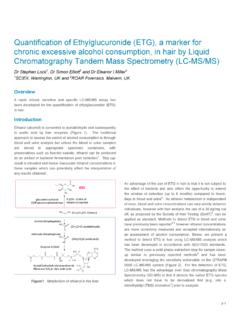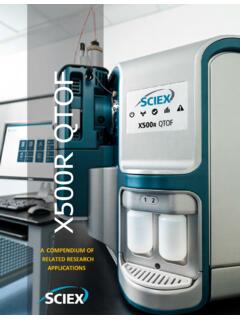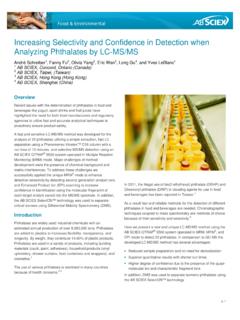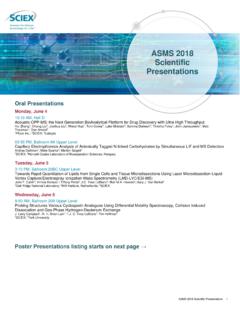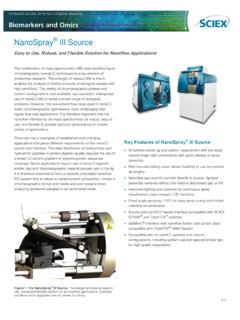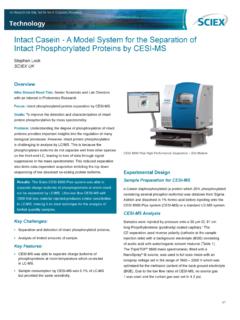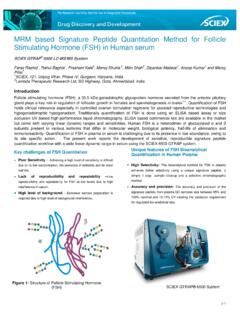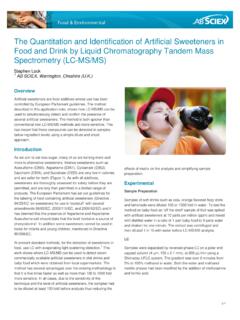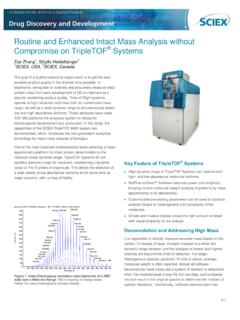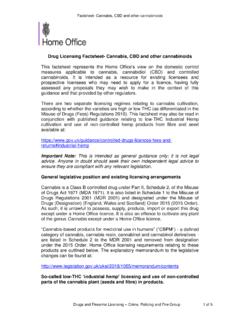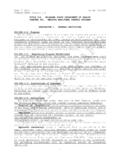Transcription of Quantitation of Oregon List of Pesticides / Cannabinoids ...
1 Quantitation of Oregon List of Pesticides and Cannabinoids in cannabis matrices by LC-MS/MS. Diana Tran1, KC Hyland1, Simon Roberts1, Scott Krepich2, Paul Winkler1, Craig Butt1, and Christopher Borton1. 1. SCIEX, USA; 2 Phenomenex, USA. Increased legalization of cannabis for medical and recreational use substantiates the need for a standardized robust and reproducible method for Quantitation of pesticide residues and relevant psychotropic Cannabinoids in cannabis products. Pesticide application in agricultural industries is intended to protect crop yield from pests or pathogens.
2 Insecticides, acaricides, fungicides or other protective chemical reagents on crops pose potential health risks both to field employees via exposure as well as consumers through consumption. Pesticides and pesticide action levels may be regulated differently by state. Currently, the most comprehensive list of Pesticides and their respective MRLs allowed in plant products is known as the Oregon List of Pesticides . performance of this method in flower represents performance in Several Pesticides on the Oregon List have been historically the most difficult matrix.
3 Monitored by GC-MS including complicated sample preparation The SCIEX vMethod Application for Quantitation of Pesticide with derivatization and relatively long sample run times. Here, a Residues in cannabis matrices provides a step by step SOP. fully verified LC-MS method is presented using two different that is suitable for use for ISO 17025 compliance, acquisition SCIEX triple quadrupole mass spectrometers for the analysis of methods with optimized source and analyte parameters as well those Pesticides comprising the Oregon Pesticide List.
4 As a Quantitation method using MultiQuant Software. The QET 4500 system presents a cost-effective platform for achieving the majority of the Oregon List Maximum Residual Key Features of Complete Solution Limits (MRL) in cannabis flower matrix. The highly sensitive A simplified sample preparation protocol complete with . SCIEX Triple Quad / QTRAP 6500+ system is capable of analysis of all 59 compounds ( Pesticides and Cannabinoids ). meeting the MRLs for the full list in cannabis flower matrix. using electrospray ionization (ESI) and LC-MS/MS.
5 cannabis flower shows the most severe matrix- induced ion A 16 minute gradient maximizes separation of endogenous suppression on the target analytes and, therefore, the isobaric interferences for pesticide analysis. A five-minute gradient separates all ten isobaric Cannabinoids from each other and ensures precision of quantitative analysis. Dilution with six pesticide deuterated internal standards and two cannabinoid internal standards during sample preparation allows for maximization of recoveries for the most analytes as well as the ability to correct for analyte recovery efficiency Fast polarity switching on the SCIEX Triple Quad / QTRAP.
6 Systems enables monitoring of targets in both negative and positive polarities in a single fast method. Figure 1: The SCIEX ExionLC AC HPLC System with the SCIEX. QET 4500 LC-MS/MS System. p1. Methods Standards and Internal Standards (IS): Pesticide standards were purchased from RESTEK (Bellefonte, PA). The complete list of Pesticides monitored can be found in the SCIEX vMethod Application for Quantitation of Pesticide Residues in cannabis matrices Deuterated internal standards were purchased from Toronto Research Chemicals (Toronto, Canada).
7 Cannabinoid standards and deuterated internal standard were purchases from Cerilliant (Round Rock, TX). The complete list of Cannabinoids monitored can be found in SCIEX vMethod Application for Quantitation of Pesticide Residues in cannabis matrices 1. Acetonitirile, methanol, water, formic acid, acetone and ammonium formate were purchased from Sigma-Aldrich ( , MO). Sample Preparation: Calibrators and quality controls were made in acetonitrile and then diluted with 75:25 (v/v). methanol:water. Unknown cannabis matrices were analyzed using gram of cannabis flower or gram of cannabis concentrates diluted in 5 mL of acetonitrile which was sonicated, vortexed and centrifuged.
8 The extract was then diluted in 1:6. (v/v) using 75:25 (v/v) methanol and water. LC-MS/MS injection volumes are 20 L for a QET 4500 system and 25 L for a QTRAP 6500+ system. The maximum injection volume for this method is 25 L in order to maintain symmetrical peak profiles of early eluting Daminozide and Acephate. Figure 2. Overview of Sample Preparation Protocols. Method for The sample extract was also used for cannabinoid potency sample preparation from cannabis flower and concentrates for pesticide residue analysis (top) and Cannabinoids (Bottom).
9 Analysis by further diluting 1:2000 (v/v) serially. The suggested LC-MS/MS injection volumes are 5 L for a 4500 system and 1. L for a QTRAP 6500+ system. An outline of the sample preparation procedures for Pesticides and Cannabinoids is shown Chromatography: Chromatographic separation was achieved in Figure 2. using Shimadzu LC-20AD binary pumps or with a SCIEX. ExionLC AC LC system and a Phenomenex Kinetex Biphenyl Column ( m, x150 mm) at flow rate of 1 mL/min. Table 1. Mobile Phases for LC Gradient.
10 The analytical column is heated to 30 C for analysis using the CTO-20AC integrated column oven for pesticide analysis and LC Reagent % Composition 35 C for cannabinoid testing respectively. The eluents used for Mobile Phase A 5mM Ammonium Formate the separation are shown in Table 1 and the gradient profile is (100 , Water: Formic Acid) shown in Table 2 for pesticide residue testing and Table 3 for Mobile Phase B 5mM Ammonium Formate cannabinoid testing. (98:2, Methanol: Water). Autosampler Wash (70:20:10).
